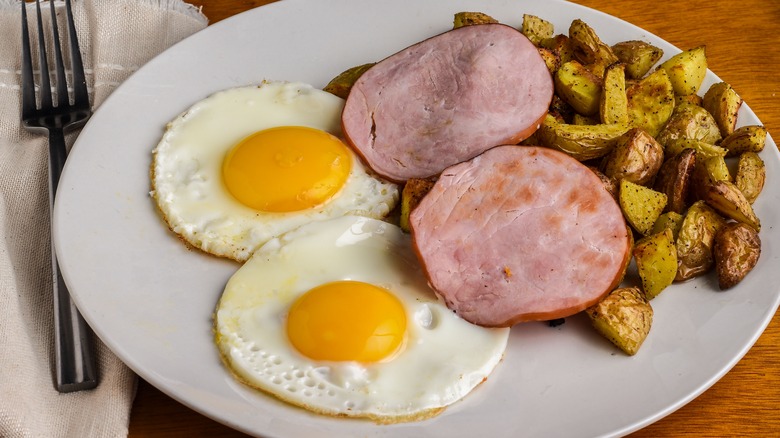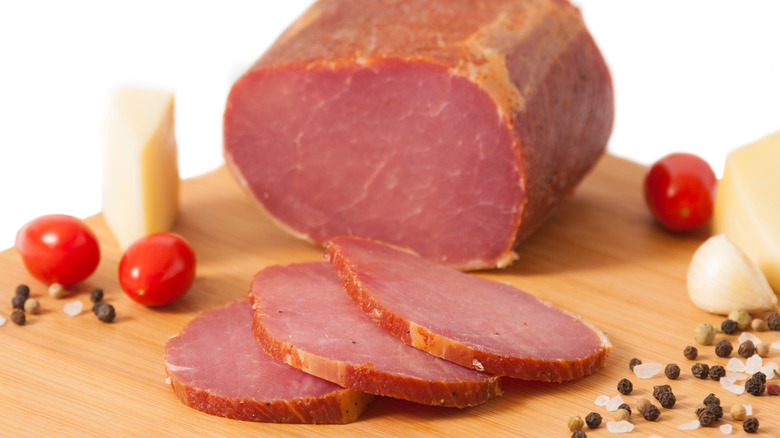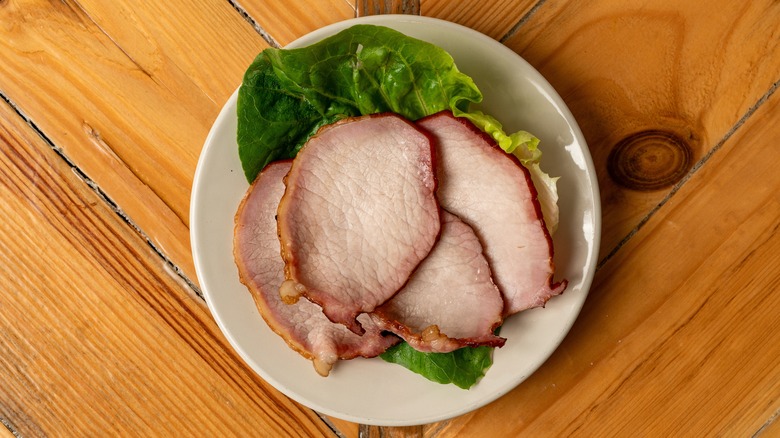What's The Actual Difference Between Canadian Bacon And Ham?
Bacon is a classic addition to a morning meal. In the U.S., it's the fatty, crispy American style that's the star. Yet, there's also a milder — but equally tasty — version employed for the job: Canadian bacon. Also known by regional names like Irish and English bacon, as well as rashers and back bacon, it's a food that shifts in nomenclature.
With its perfect round pieces absent of fat, it looks like ham, especially brined deli-style slices. Yet its name and breakfast associations seem to group it alongside other bacon types. And its gentle, slightly sweet and salty flavor can further complicate its distinction.
Well, Canadian bacon and ham are in fact pretty different: They're sourced from separate parts of the pig and employ alternate preparation methods. So next time you're glancing at the meat products on the shelf, or looking for the correct meat for your eggs benedict, know that the two, although similar-looking, aren't interchangeable.
Canadian bacon is sourced from the back
The most principal distinction of Canadian bacon is its sourcing; it hails from the back. Conversely, the term ham encompasses a large array of products, all of which must be sourced from the hind leg. As a result, the two foods pack in contrasting attributes by virtue of their original butchering.
Like different bacons in the U.K., the Canadian variety comes from the loin, a large muscle that has a small amount of fat on top. A lean cut, there's limited marbling present in this region, which is why Canadian bacon has a much meatier quality. Such a consistency makes it similar to leaner center cut hams, as opposed to the decadent fattiness of a cut like Spanish jamon iberico. Additionally, unlike some hams, Canadian bacon does not come with bone-in varieties.
The large, round nature of pork loin lends Canadian bacon its circular shape. Conversely, ham is butchered from three regions of the leg, which result in diverse shapes due to the internal bone structure. As a result, you'll find ham in forms that range from large uncarved pieces to steaks, cubes, varying slices, and more.
While most hams are cured, Canadian bacon is brined
Furthermore, Canadian bacon goes through a different preservation process than most hams. Like other types of bacon, the meat spends time in a salt-water bath for preservation. Such a brining procedure makes it more akin to city hams, those lean and large brined pork products associated with Christmas and Thanksgiving. There's no prolonged drying process or dry rub like with prosciutto varieties, which means Canadian bacon offers a more naturally meaty flavor. With all the brine liquid, the cut is delightfully juicy in consistency, hence no fear of it ever drying out. Plus, seasonings and sweeteners (like maple syrup) are used to flavor Canadian bacon, lending it a mildly aromatic palate.
Nevertheless, some producers may cure their Canadian bacon with nitrates, lending two varieties like with cured and uncured hot dogs. And smoking Canadian bacon is common, although the process doesn't impart a bold taste. So overall, this processed pork derives less flavor from the production process as opposed to other ham varieties.
Canadian bacon intertwines with breakfast preparation
Much like its American counterpart, Canadian bacon is most strongly associated with breakfast preparations. Despite the warring theories surrounding the invention of eggs benedict, Canadian bacon is a foundational component in practically all iterations of the recipe. You'll also find the product in delicious breakfast sandwich renditions, sliced alongside cheese into fluffy rolls. And it's a common filling to everything from omelets to breakfast quesadillas. Its balanced saltiness, slight sweetness, and low amount of fat makes it easier to integrate into breakfast than bold ham types.
Nevertheless, some brined city ham varieties do mimic Canadian bacon's flavor and consistency, so there are some shared uses between the two. Whether it's in pasta, atop Hawaiian-style pizza, or in a split pea soup, both will craft a delicious result. Just note that while Canadian bacon comes already cooked, it's rarely eaten raw, and is typically seared — a contrast to packaged hams. Yet just give it a few minutes in the pan, and it's the ideal candidate for a morning start.



